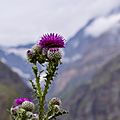Lahaul and Spiti district facts for kids
Lahaul-Spiti is a special district found high in the Himalayas in the Indian state of Himachal Pradesh. It was formed by joining two areas that used to be separate: Lahaul and Spiti. This district is known for its amazing natural beauty, with towering mountains, deep valleys, and winding rivers. It's a place of adventure and unique culture.
Contents
Exploring Lahaul-Spiti: A Mountain Wonderland
Lahaul-Spiti is a land of incredible contrasts. It has rugged, snow-capped peaks and dry, desert-like landscapes. The district is mostly made up of two main valleys, Lahaul and Spiti, each with its own distinct feel.
Geography and Landscape
The district is located in the northern part of Himachal Pradesh. It is surrounded by high mountain ranges. The Pir Panjal Range separates Lahaul from the Kullu Valley. The Great Himalayan Range separates Lahaul from Zanskar. The Kunzum Pass is a high mountain pass that connects the Lahaul and Spiti valleys. This pass is often closed by heavy snow for many months of the year.
Rivers and Valleys
The Chandra and Bhaga rivers flow through the Lahaul valley. They meet to form the Chenab River. The Spiti River flows through the Spiti valley. These rivers are fed by melting glaciers and snow. They create deep gorges and fertile patches of land where people live.
Climate and Seasons
Lahaul-Spiti has a very cold and dry climate. Winters are long and harsh, with heavy snowfall. Temperatures can drop far below freezing. Summers are short and mild. Most of the rain and snow falls during the winter months. This makes the region a cold desert.
High Altitude Living
Because of the high altitude, the air is thin. Visitors often need time to get used to it. The clear skies offer amazing views of the stars at night. The extreme weather means that life here is tough but beautiful.
Life and Culture in Lahaul-Spiti
The people of Lahaul-Spiti have adapted to their challenging environment. They have a rich culture, deeply influenced by Tibetan Buddhism. Their way of life is closely connected to the land and its seasons.
People and Languages
The people living in Lahaul are called Lahaulis. Those in Spiti are called Spitians. They speak different dialects, but many also speak Hindi. Their traditions and customs are very old.
Festivals and Traditions
Many festivals are celebrated throughout the year. These often involve traditional dances, music, and religious ceremonies. They are a time for communities to come together. Monasteries play a central role in the cultural life of the region.
Agriculture and Economy
Farming is the main way people make a living. They grow crops like potatoes, peas, and barley. These crops can grow well in the short summer season. Tourism is also becoming more important. Many people visit to see the beautiful landscapes and ancient monasteries.
Traditional Homes
Homes in Lahaul-Spiti are often built from mud bricks and wood. They are designed to keep warm during the cold winters. Many houses have flat roofs used for drying crops.
Wildlife and Nature
Lahaul-Spiti is home to some rare and amazing animals. The rugged terrain and cold climate support unique plant and animal life.
Animals of the Mountains
You might spot animals like the snow leopard, Himalayan ibex, and blue sheep. These animals are well-adapted to living in high altitudes. Birdwatchers can look for species like the Himalayan monal and the yellow-billed chough.
Plant Life
Despite the harsh conditions, various plants grow here. Many wildflowers bloom during the short summer. Medicinal herbs are also found in the region. The landscape changes from green valleys in Lahaul to barren, rocky areas in Spiti.
Historical Monasteries and Forts
Lahaul-Spiti is famous for its ancient Buddhist monasteries. These monasteries are not just places of worship; they are also centers of learning and art.
Key Monasteries
The Key Monastery (also known as Ki Gompa) is one of the most famous. It is built on a hilltop and looks like a fort. The Tabo Monastery is another important site. It is known as the "Ajanta of the Himalayas" because of its old frescoes and paintings.
Ancient Forts
The Gondla Fort is an old tower-like building in Lahaul. It offers a glimpse into the region's past. These structures tell stories of ancient kingdoms and spiritual traditions.
Visiting Lahaul-Spiti: A Journey of Discovery
Many people visit Lahaul-Spiti for adventure and peace. It's a great place for trekking, photography, and exploring nature.
Popular Attractions
- Chandra Taal: A beautiful crescent-shaped lake.
- Bara-lacha la: A high mountain pass connecting Lahaul to Ladakh.
- Pin Valley National Park: Home to snow leopards and other wildlife.
- Kaza: The main town in Spiti, a good base for exploring.
Getting There
Access to Lahaul-Spiti is often difficult, especially in winter. The Rohtang Pass and Kunzum Pass are key routes. The Atal Tunnel has made travel to Lahaul much easier and quicker. It allows access even when Rohtang Pass is closed.
Images for kids
-
Bara-lacha la pass between Lahaul and Ladakh
-
Tributary of Chandra River from Rohtang Pass
-
Chandra River upstream of Rohtang Pass
-
Chandra Taal near the source of the Chandra River
-
Yellow-billed chough, Pin Valley
See also
 In Spanish: Distrito de Lahaul y Spiti para niños
In Spanish: Distrito de Lahaul y Spiti para niños






























